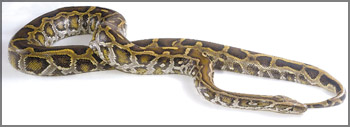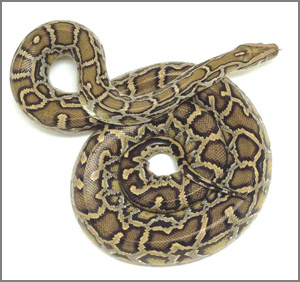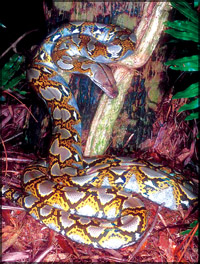Giants among snakes!
Today we introduce three more interesting species of snakes from the
family of pythons which are considered to be among the largest snakes in
the world. You are sure to be familiar with one species because it is
native to our land. So, let’s slither along with these giant reptiles
and learn more about the creatures that share this planet with us ...
Indian python
 The
Indian python also belongs to the family of Boidae which includes boas
and anacondas. It is considered to be among the largest snakes in the
world. The
Indian python also belongs to the family of Boidae which includes boas
and anacondas. It is considered to be among the largest snakes in the
world.
The Boidae family is further divided into sub families and pythons
belong to the family of Pythoninae. The Indian is one of two sub
species, the other being the Burmese python. Both species of pythons are
commonly referred to as the Asian rock pythons.
The Indian python is found in Pakistan, Bangladesh, Nepal, Sri Lanka
and of course India. It lives in a wide range of habitats such as
woodlands, river valleys, forests, marshes, swamps and rocky hills too.
It is considered to be one of the largest snakes because it reaches
lengths of over six metres. There have been reports of Indian pythons
which are about 20 feet long! These pythons reach weights between 70-120
pounds (32-55 kgs). You can imagine how large they can grow to be.
The typical Indian python will have a skin pattern of black-edged
brown patches on a pale orange-brown to yellow-brown background. A
distinctive lighter coloured, forward pointing V shaped marking is
visible on the head.
A highly arboreal snake, the Indian python, like most pythons is a
solitary snake. It is adept at swimming and climbing trees. It could be
often seen wrapped around the branches of trees.
 Its
diet consists of fish, birds and mammals. The latter is the preferred
food. If the python manages to catch a large prey it may not need to eat
again for a very long time. In captivity, the Indian python is recorded
to live up to 20 years. Its
diet consists of fish, birds and mammals. The latter is the preferred
food. If the python manages to catch a large prey it may not need to eat
again for a very long time. In captivity, the Indian python is recorded
to live up to 20 years.
The female lays about 60 eggs in a rock crevice or tree hole and
incubates the clutch for 100 days. Throughout this long period, the
female stays with the clutch, leaving the eggs only to drink water, when
absolutely necessary.
It warms the eggs by controlling its body temperature. This is
achieved by constricting (squeezing together) or twitching her body
muscles. The eggs are kept warmer than the temperature in the
environment.
The small pythons, when hatched, are about 18-24 inches (46-61 cm) in
length. They shed their skin for the first time within 7-10 days of
birth. During the first year of life, the young pythons double or triple
in length.
Burmese python
The largest subspecies of the Indian python and one of the six
biggest snakes in the world, it is native to rainforests of southeast
Asia including Burma (Myanmar), Thailand, Vietnam, China and India.
It is often found near water, in grasslands, meadows, swamps,
river-valleys and jungles. It can be seen in open areas too.
The largest of the snakes reaching lengths of 7 mts (23 ft) and
weights of around 91 kg (200 lbs), the Burmese python continues to grow
throughout life. The reason it reaches such great lengths is the large
number of vertebrae it has.
 The
Burmese python is generally light coloured with dark brown blotches
bordered in black, down the back. The skin design has led to the python
being popular in the leather industry and among reptile keepers. The
Burmese python is generally light coloured with dark brown blotches
bordered in black, down the back. The skin design has led to the python
being popular in the leather industry and among reptile keepers.
Many giant pythons are killed for their skin. Even though this
species of python lives close to water, and is a skilled swimmer. It’s a
good climber too and goes up trees to catch prey. The Burmese python
uses the prehensile tail to capture prey. When in water, it can stay
submerged up to half an hour.
At home, both on the ground and on trees, the Burmese python spends
most of its time hidden in the underground.
Like all pythons, the female remains with the clutch of eggs which
can comprise 12-36 eggs, until they are hatched. But once the eggs are
incubated and the baby pythons use their ‘egg tooth’ to cut their way
out, no maternal care is provided. Now just in case you are wondering
what an ‘egg tooth’ is, let us enlighten you.
It is a small, sharp protrusion around the head area, which is used
by the offspring. Most birds and reptiles have it. It is located at the
end of the nose in snakes.
This nocturnal rain forest dweller is carnivorous and consumes birds
and mammals. It uses its sharp, backward pointing teeth to seize prey
and then wraps its body around the victims, contracting the muscles all
the time.
This powerful python is often captive bred for colour, pattern and
more recently for size. The albino form of the Burmese python is very
popular and is the most widely used morph. It is basically white with
patterns of butterscotch yellow and burnt orange.
Then there are the khaki coloured ‘green’ Burmese python and the
‘Granite’ Burmese pythons. They have small angular spots on the body.As
the demand for designer pet pythons grows, more and more morphs are
being developed by python breeders.
Reticulated python
One of the three Old World(Africa, Asia and Australia) pythons, the
reticulated python is native to coastal South East Asia, from Myanmar to
Nicobar Islands, east of the Malaysian Peninsula, Vietnam and most of
Indonesia and Philippines Islands.
 It
lives in a variety of habitats such as woodlands, dense forests, rocky
areas, lakes, rivers and swamps. It is rarely found away from fresh
water. It
lives in a variety of habitats such as woodlands, dense forests, rocky
areas, lakes, rivers and swamps. It is rarely found away from fresh
water.
The reticulated python is characterised by its attractive, irregular,
diamond-shaped outline on its skin which is highlighted by smaller white
spots with a light brown background.
This net-like design on the body is a complex geometric pattern which
incorporates a number of colours.
The word reticulates in Latin means net-like and refers to the
markings on the body of the python. This species, though commonly known
as the reticulated python, is also called the Asiatic reticulated python
and the regal python.
This non-venomous python competes for the record of the world’s
largest snake with the South Asian green anaconda. On average, it grows
to lengths between 10-20 ft, but pythons about 34 feet have also been
recorded.
The reticulated python weighs about 200 lbs or even more though it is
rather slender compared to some pythons. The temperament of the python
changes according to the geographical region.
Some are calm and docile in captivity while others are irritable and
defensive. A non-social creature which prefers to lead a solitary life,
this carnivorous python feeds on a large variety of prey such as water
fowls, and small to medium animals; pigs, dogs, goats and large deer. It
is known to snatch stray chickens, cats and dogs. Occasionally human
beings are included in its diet.
As with all pythons, reticulated pythons too are ‘ambush hunters’.
They wait until the prey comes close enough to strike and then seizes
it. The prey is then killed and consumed in typical python fashion.
The female lays a clutch of 25-100 eggs. Each egg is about 10-13 cm
(4-5 inches) in length and is yellowish or white coloured. As the slimy,
eggs are soft and sticky, it prevents the eggs from becoming dry.
The eggs are protected by the mother until they are hatched. The
hatchlings, when born, are about two feet long. They grow (the same
length at birth) every year to become the enormous pythons many of us
are wary of.
Fact file
* The name python comes from a giant serpent in Greek mythology.
* Snakes have been held as symbols of evil in ancient times by some;
the Biblical serpent in the Garden of Eden is a good example of this.
* In ancient Egypt, the emblem of judgment and death was a snake.
* Snakes belong to the group of reptiles which include crocodiles,
lizards and turtles.
* Snakes are believed to have evolved from prehistoric lizards which
lived during the time of the dinosaurs.
* Most pythons have tiny projections-spur-like hind limbs where legs
are believed to have once existed. It is more prominent in males. This
is one of the reasons why they are considered to be some of the most
ancient species of reptiles.
* Pythons can temporarily increase the size of their hearts to
improve the blood supply needed for digestion, especially of large prey.
* Their digestion is affected by the warm or cool external
temperature; it can raise or lower the snake’s metabolism.
* If the digestive process takes too long or if the meal is too
large, the victim’s body begins to decay inside, causing blood
poisoning. In rare cases, this releases gases that cause the snake to
burst open.
* Skin pattern is formed like a mosaic - each pattern element is made
up of hundreds of separate scales each of which is a single colour.
* Pythons are considered primitive snakes because they have two
functioning lungs-one small, one large. More advanced snakes have a
single lung.
* Some species of snake have as many as 400 sets of ribs.
* The jaws can have up to 200 backward curving teeth, designed to
grip prey and prevent them from pulling away once the victim is caught.
* The powerful digestive juices break down bones, horns, teeth, as
well as hide and flesh.
* A python typically swallows its prey, starting with the victims
head.
* Scientists have recorded eight genera and 325 species of pythons.
* Apart from the fact that pythons lay eggs and boa’s give birth to
live young, there is another feature that differentiates pythons from
boas; the heat sensing pits in a python is located on the upper lip,
within the scales while in a boa’s, they are placed between the scales. |
